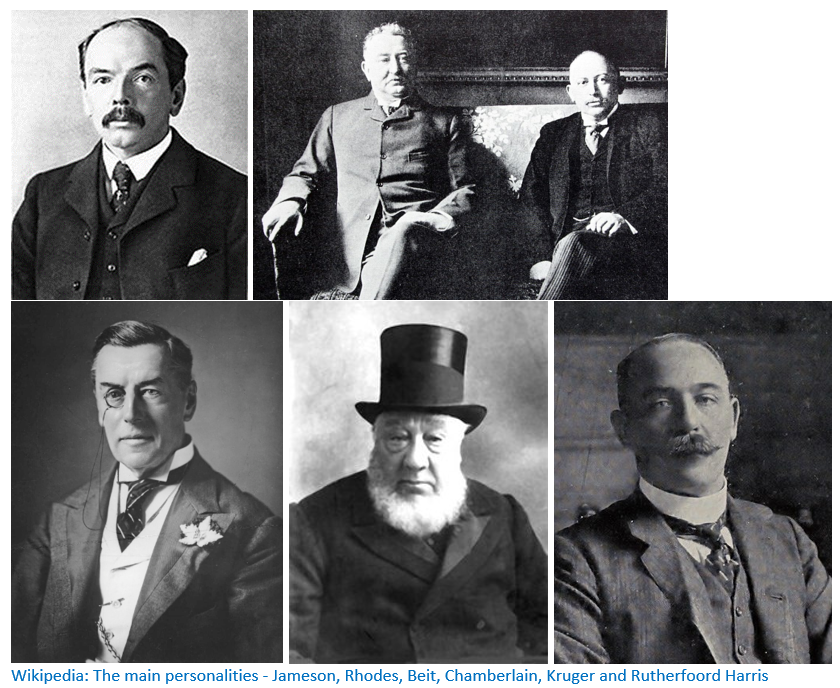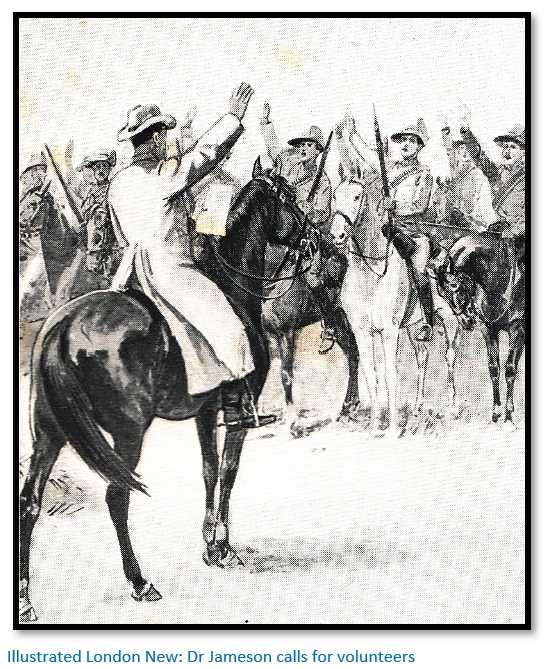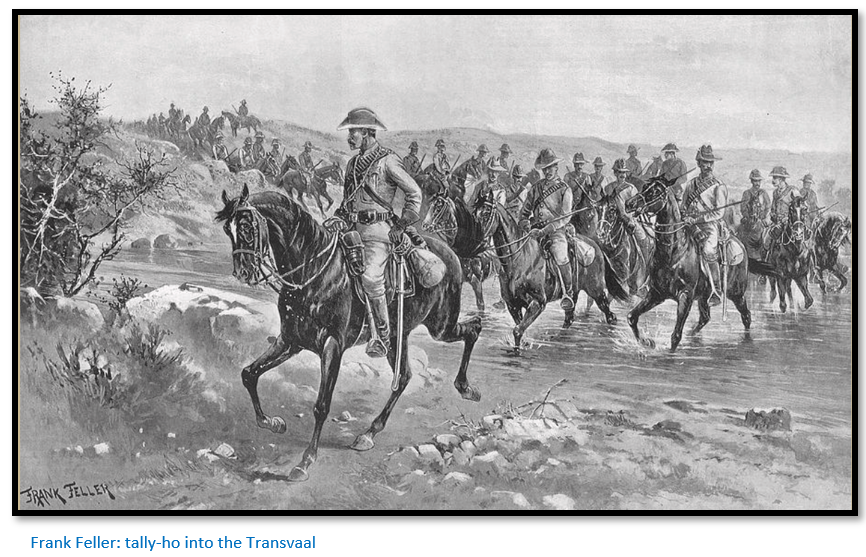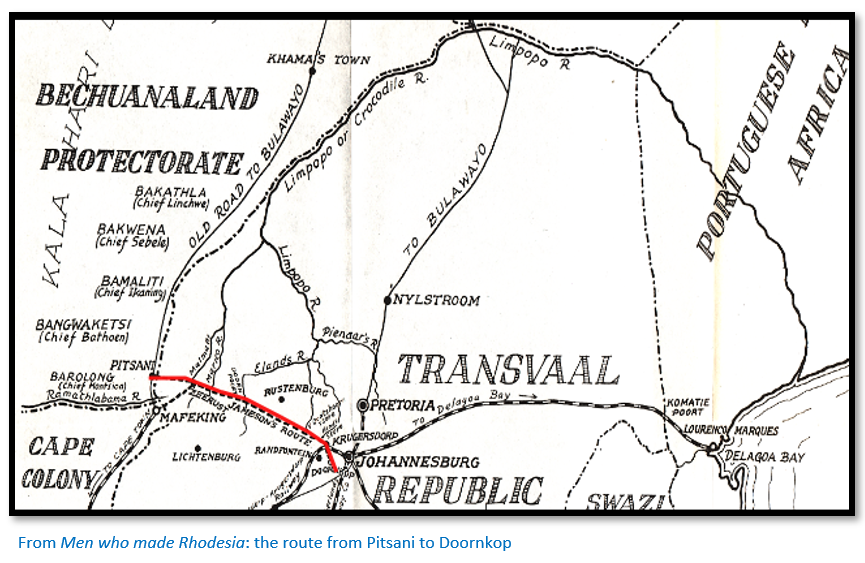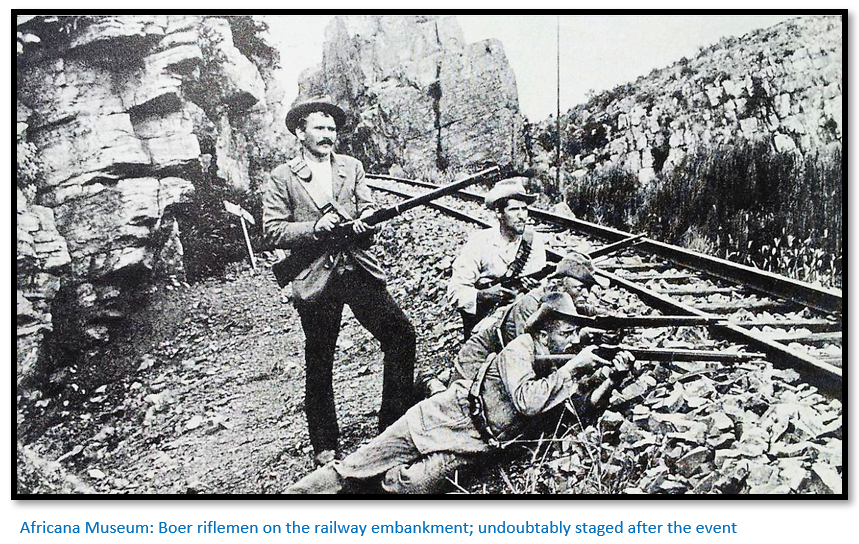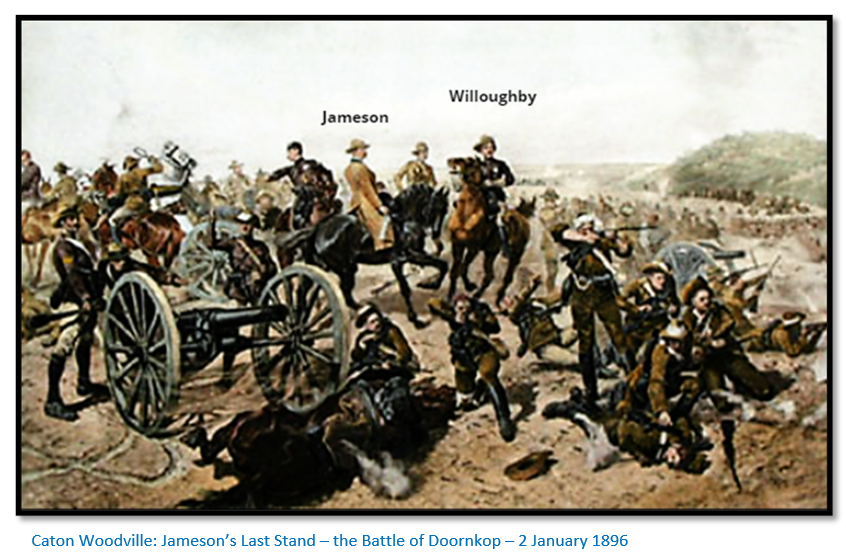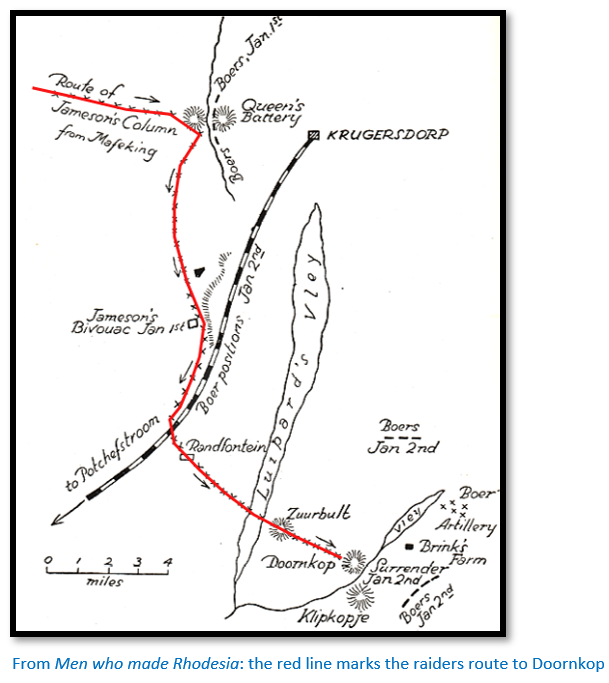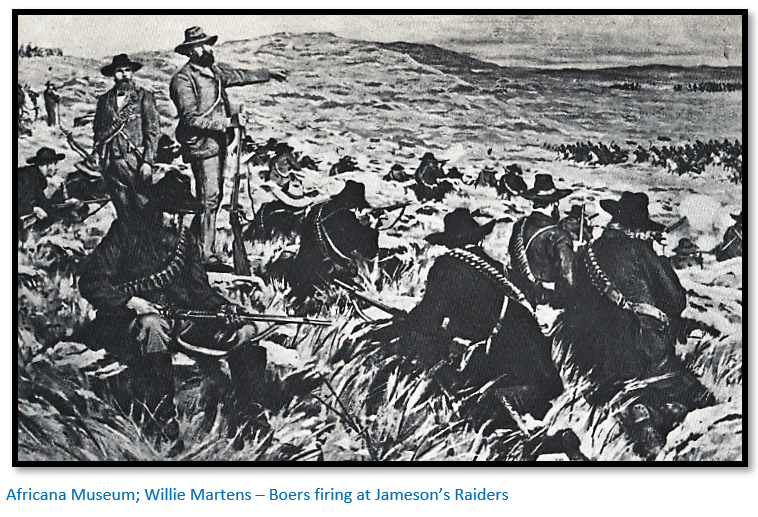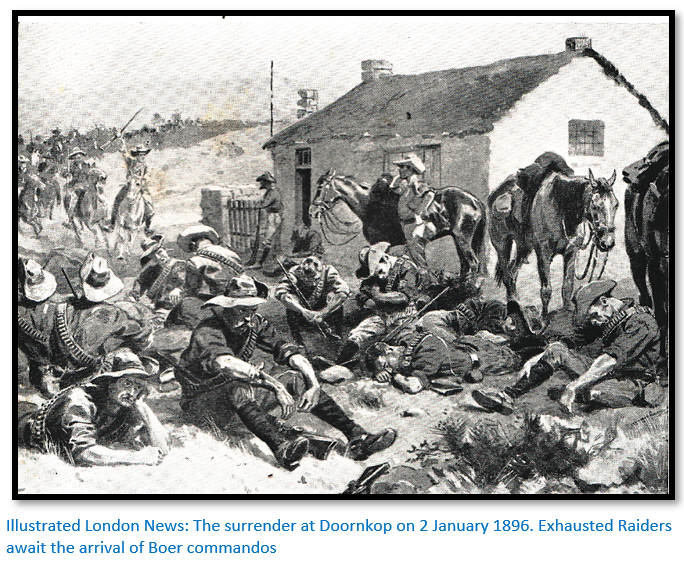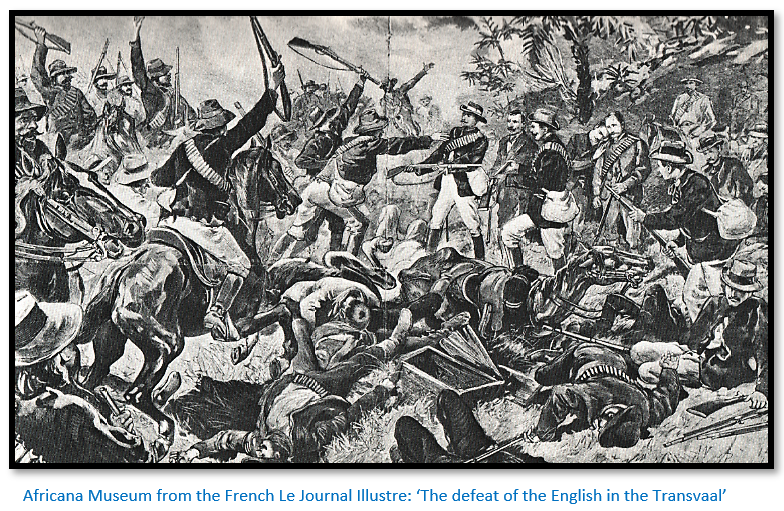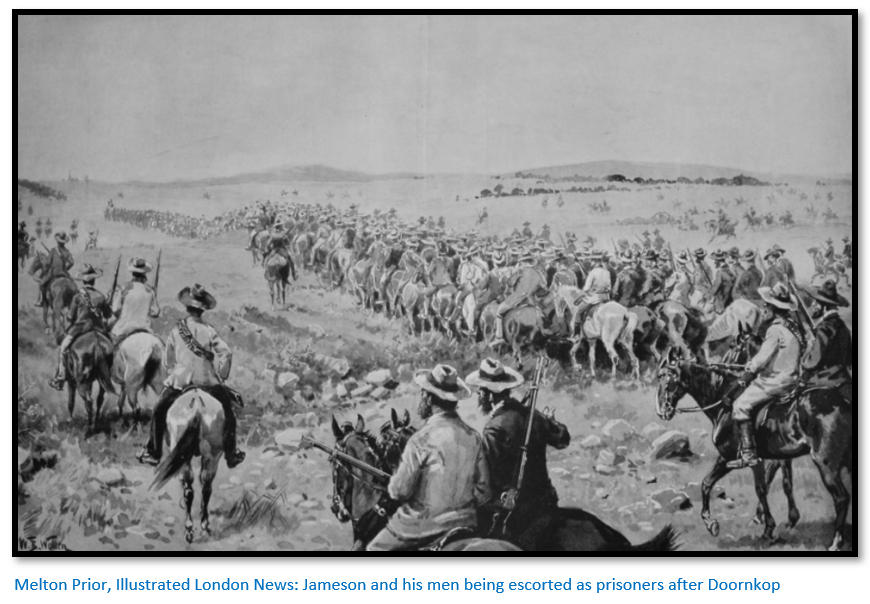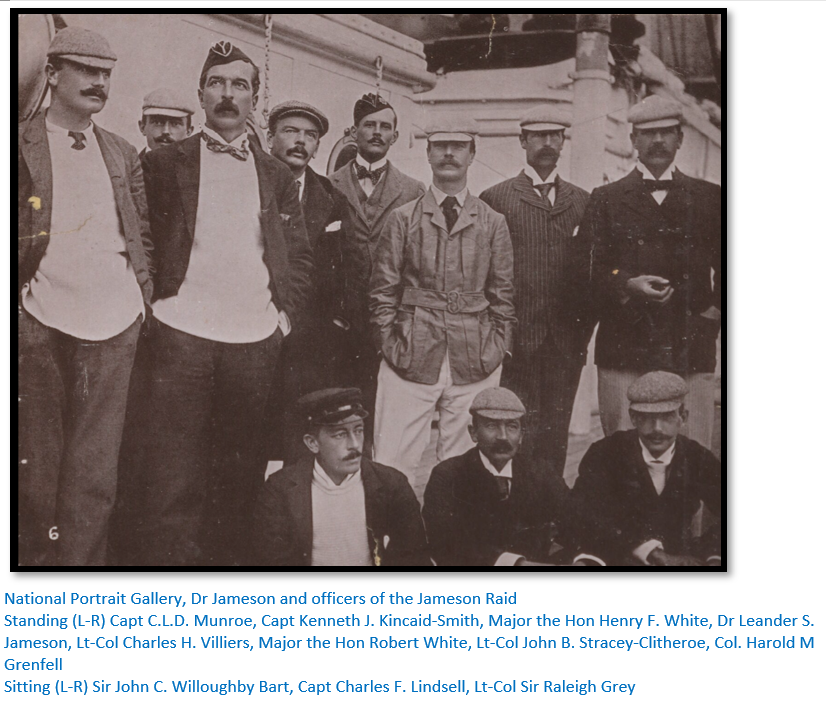The Jameson Raid
Introduction
The Jameson Raid caused enormous interest and controversy at the time and arguably was one of the main causes of the Anglo-Boer War of 1899-1902. Led by Cecil Rhodes' lieutenant and closest confidant, Dr Leander Starr Jameson, it was an unskilful attempt at overthrowing Paul Kruger’s Transvaal Republic (Dutch: Zuid-Afrikaansche Republiek; the ZAR) with the help of the English-speaking ‘uitlanders’ and the gold barons of the Rand Reform Committee and substituting some form of British government. The plan went wrong from the start and Jameson’s troopers of the Matabeleland and Mashonaland Mounted Police (MMP) and ex-Bechuanaland Border Police (BBP) were easily defeated by the Boer Commandos.
Innumerable books have been written up about the main conspirators - Cecil Rhodes, Alfred Beit, Frederick Rutherfoord Harris,[i] Sir Hercules Robinson and Joseph Chamberlain[ii] - and “who knew what” but this article concentrates on the build-up and military progress of the Raid itself. The political fallout was immense as the Raid was seen as the inexcusable invasion of a friendly country. It included Rhodes being forced to retire as Prime Minister of the Cape Colony, tensions increased between the ZAR and Britain and lit the fuse for the start of the Anglo-Boer War on 11 October 1899.[iii]
The Raid depleted Matabeleland and Mashonaland of their police forces, that along with other factors, probably contributed to the outbreak of the Matabele Rebellion of First Umvukela.
Many of the quotes below are from Hugh Marshall Hole who worked with Jameson (“Dr Jim”) as his private secretary from 1891 to 1893 when Jameson was Administrator of Mashonaland; Marshall Hole was well aware of his strengths as well as weaknesses which included his love of a gamble and almost reckless acceptance of heavy odds.
On 28 January 1897 Secretary of State for the Colonies Chamberlain proposed: “That a Select Committee he appointed to inquire into the origin and circumstances of the incursion into the South African Republic by an armed force, and into the administration of the British South Africa Company, and to report thereon, and further to report what alterations are desirable in the government of the territories under the control of the Company; that the Committee have leave to hear counsel to such extent as they shall see fit, and have power to send for persons, papers, and records.”[iv]
Much of Marshall Hole’s information comes from evidence to the Select Committee which I have omitted in this article.
December 1894, preparations begin
According to Marshall Hole, in September 1894 on a short visit to Rhodesia by Rhodes and John Hays Hammond[v] to view gold properties, they travelled with Jameson and heard Hammond say: “that it was impossible for the economic condition of the Rand to continue and that unless a radical change was made there would be a rising by the people in Johannesburg.”
They decided to achieve that goal: “the extension of the railway from Mafeking will be the card to play.” Thus Rhodes, Jameson and Capt. Sir John Willoughby[vi] travelled to England to discuss with the Foreign Office the British South Africa Company’s (BSACo) sphere of influence north of the Zambesi river, to get permission to extend the railway line from Mafeking to Bulawayo and to get a grant of administrative powers for the BSACo over a strip of land alongside the proposed railway line. They were successful in their negotiations.
From the directors of the BSACo they wanted authority to increase the military forces in Mashonaland and Matabeleland, then numbering 350, by raising a volunteer corps in each province and to purchase rifles and Maxim guns to equip 1,500 men. Again, they were successful, and arms were purchased from 17 January 1895.
Establishment of the Rhodesia Horse and police administration in the Bechuanaland Protectorate
In April 1895, whilst still in England, Willoughby was gazetted to command the new volunteer unit, the Rhodesia Horse.[vii] Both Hickman and Marshall Hole state that from the outset Willoughby knew this outfit was planned for action against the Transvaal republic[viii] as soon as an opportunity presented itself to rescue the uitlander[ix] population of the Rand.
The Matabeleland division of the Rhodesia Horse was commanded by Capt H M Heyman,[x] the Bulawayo Civil Commissioner, the Mashonaland division by Lieut-Col. the Hon Harry F White who in September 1895 also assumed command of the Rhodesia Mounted Police succeeding his brother Capt. The Hon Charles White. By December 1895 Charles White was in Johannesburg advising Col. Frank Rhodes[xi] and the Reform Committee.[xii]
In addition, the Foreign Office agreed that the Matabeleland Mounted Police should have jurisdiction along the proposed railway route[xiii] and on 18 October 1895 Jameson was gazetted as Resident Commissioner over the tribal areas of Chiefs Montsioa and Ikaning near Mafeking extending to Khama’s border with a railway strip through Khama’s territory to the Matabeleland border.
The Foreign Office welcomed the idea as they hoped to reduce the size of the Bechuanaland Border Police (BBP) as the BSACo agreed to absorb as many BBP men as wished to transfer and take over their stores and equipment.
The Matabeleland and Mashonaland Mounted Police[xiv] move to Pitsani
On 29 October 1895 the Hon Robert White, Chief Staff officer and the third of the White brothers, arranged to establish a police camp at Maliet farm near Pitsani, now Pitsane Photlokwe, which was inspected and approved by Jameson a day or so afterwards. It was ideally situated, a coach stop on the route between Mafeking and Bulawayo, just 5 kms (3 miles) from the Transvaal Republic (ZAR) border and with a permanent water supply, a quiet spot out of the way for training.[xv] Crucially any fireside theories as to their final objectives would remain within camp, the essence of the scheme was secrecy.[xvi]
Two days following Jameson’s appointment Inspector Straker with eighty men of the Matabeleland Mounted Force and two Maxims moved out of Bulawayo…most people, including the police, thought they were being sent to protect the railway construction work if there was trouble from the tribes. Straker and his men arrived at Pitsani on 30 November 1895 and were followed by other detachments including one from the Mashonaland Mounted Police under Sub-Inspector Tomlinson. In all 380 of the mounted police – then called British South Africa Company Police, left the country, leaving just forty in Matabeleland under Inspector Southey. About 100 men of the BBP transferred under Lieut-Col. Raleigh Grey, less than the 200 that Jameson hoped for, but remained at Mafeking (now Mahikeng)
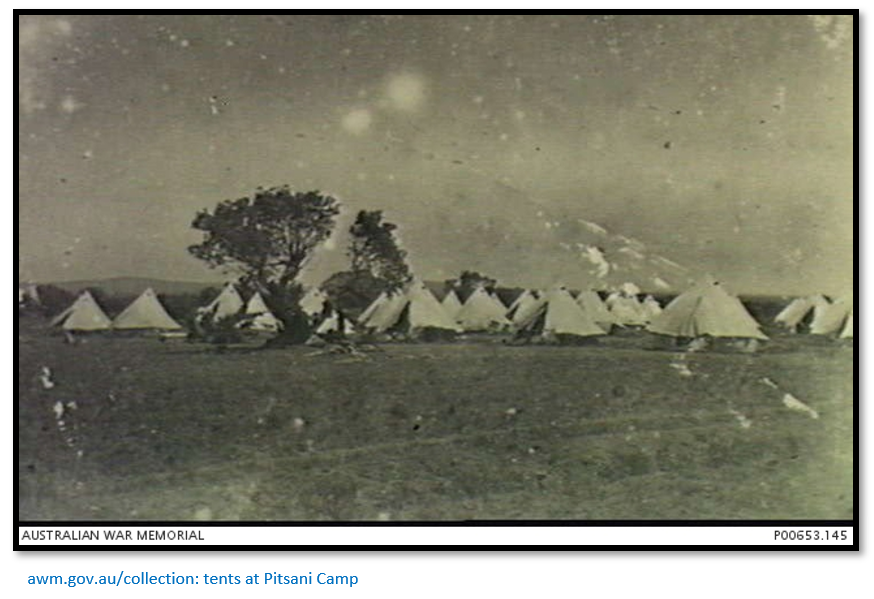
The smuggling of arms and ammunition into Johannesburg was organised through Gardner Williams[xvii] and the De Beers organisation. However, rumours were rife amongst the miners and President Kruger was well aware of the plot and told the burghers at Bronkhurst Spruit: “Wait until the time comes. Take a tortoise; if you want to kill it you must wait until it puts out its head and then you cut it off.”
Marshall Hole says that Foreign Office officials, including Chamberlain and Fairfield also knew a plan was afoot regarding the impending crisis in the Transvaal and that Bechuanaland had something to do with it.
Jameson addresses the men
Despite receiving coded telegrams from the Reform Committee to call off the Raid: “26 December. It is absolutely necessary to postpone flotation through unforeseen circumstances here altogether unexpected…We will endeavour to meet your wishes as regards December, but you must not move until you have received instructions to…” But Jameson grew impatient with the constant delays and sent Rhodes a telegram on 29 December 1895: "Unless I hear definitely to the contrary, shall leave to-morrow evening" and then another: "Shall leave to-night for the Transvaal.”
However, transmission of the first telegram was delayed and both arrived in Cape Town on 30 December when there was no way of recalling Jameson. Two messengers, Captains Maurice Heany and Holden who were sent by the Reform Committee forbidding Jameson to march, actually joined the Raid![xviii] Heany had been asked by the Reform Committee what Jameson would do when he received the message: “He will come in as sure as fate.” Lionel Phillips, a key Reform Committee member, telegraphed Alfred Beit: “It is absolutely necessary to delay floating. If foreign subscribers insist on floating without delay anticipate complete failure.” Rutherfoord Harris telegraphed Jameson: “Goold Adams arrives Mafeking Monday and Heany, I think, tonight. After seeing him you and we must judge regarding flotation, but all our foreign friends are now dead against it and say public will not subscribe one penny towards it even with you as a director. Ichabod!”[xix]
Capt Holden reached Pitsani first. Heany arrived later by train and then mail coach and found Jameson sitting in his bell-tent. Having received the message, Jameson got up and left the tent and for twenty minutes paced up and down alone, whilst all around him in the camp the atmosphere was tense with expectation. It was now or never. Heany waited in his tent. “I am going in and you – what will you do?” Heany replied promptly: “Go in with you.”
On Sunday 29 December 1895 around 3pm Jameson addressed the men at a general dismounted parade where they formed up in a square and he told them there was a crisis and they needed to ride the next three days to cover the 275 kms (170 miles) to help the men, women and children on the Rand and ‘restore order’.[xx] Most believed it would be a ‘great adventure’ and that the Raid had ‘official’ sanction and they would be in Johannesburg before the Boer commandos could mobilize.
Rhodes is said to have exclaimed: “Jameson has taken the bit between his teeth and bolted.” The telegram that reached Abe Bailey read: “The veterinary surgeon has left for Johannesburg with some good horseflesh and backs himself for seven hundred” and Arthur Lawley’s telegram read: “The contractor has started on the earthworks with 700 boys; hopes to reach terminus on Wednesday.”[xxi]
They would leave immediately and be joined at Malmani[xxii] a former mining town now called Ottoshoop (Ottos’ hope) on the present-day road between Mafeking and Zeerust by their BBP comrades from Mafeking under Grey. Heany says they cheered and sang ‘God save the Queen.’ Everyone present stepped forward and volunteered to go.
The officers and 356 NCO’s and men left at sundown with one day’s rations, 120 rounds of ammunition and 23 kgs (50 lbs) of horse feed. Tents and stores were left behind; a 12½-pounder field gun and six Maxim guns on galloping carriages were taken with their ammunition in scotch carts.
In Mafikeng a similar parade of F, G and K Troops of the BBP was addressed by Lieut-Col Grey and Major Coventry and at 10pm the same evening 122 of all ranks left with two 7-pounder guns and two Maxim guns. All officials in Mafeking were kept in the dark and the telegraph line was cut three miles south of Pitsani and three miles south of Mafeking.
The complete force (Pitsani and Mafeking) comprised:
| Officers | NCOs & men | Total |
Staff | 17 |
| 17 |
MMP | 19 | 356 | 375 |
BBP | 6 | 113 | 119 |
42 | 469 | 511 |
In addition, Major Crosse, late 5th dragoons, accompanied the column as a spectator.
In total there were eight Maxim guns, two 7-pounder guns and one 12½-pounder gun, 640 horses and 158 mules with about 150 native drivers, leaders, etc.
A critical mistake: surprise is lost
During the night Jameson and his troops travelled 63 kms (40 miles) and arrived at Malmani (Ottoshoop) at 5:30am on Monday 30 December with the BBP men arriving shortly afterwards. They gathered at the local store (still standing) where a two hour break was taken to make final preparations for the march of the combined groups on Johannesburg where they expected to hear the cheers of the crowd. A rear party was left, Hickman states under Lieut A H J Hore that was ordered to cut the telegraph line to Pretoria. Unfortunately, they went to one of the remaining hotels where they celebrated too well and failed to cut the telegraph line…some accounts say they cut a fence wire instead!
The local Mining Commissioner, David Marais, hearing their news, saddled his horse and rode to Mafeking where he telegraphed Pretoria with the news of the imminent raid, the line having been repaired by 1:30pm the next day.
Jameson’s force continues on towards Johannesburg
Now warned, a Boer commando from Lichtenburg arrived at Ottoshoop three hours after they had left.
At midday a messenger from Zeerust brought a letter from J D L Botha, the Marico district commander saying the column’s action was in conflict with the law of the land and a breach of international convention. Jameson replied: “30 December 1895. Sir, I am in receipt of your protest of the above date and have to inform you that I intend proceeding with my original plans, which have no hostile intention against the people of the Transvaal; but we are here in reply to an invitation from the principal residence of the Rand to assist them in their demand for justice and the ordinary rights of every citizen of a civilised state. YF, L S Jameson”
Stores along the line of march to Johannesburg had been well-stocked with supplies for the men and horses so the column could travel light and through the night.[xxiii] At Doornpoort which was reached in the early morning of Tuesday 31 December 1895, remount horses had been left; but few of the remounts had been broken to the saddle and the men continued on with their by now tired horses.[xxiv]
Jameson learns that the game is up; the Transvaal authorities know they are coming
At Elands River[xxv] later on Tuesday morning L/Sgt J.T. White of the BBP caught up with the column with a despatch from the Resident Commissioner of Bechuanaland, F J Newton stating he had orders from the High Commissioner Sir Hercules Robinson for the immediate return of the force.
Willoughby, the military commander of Jameson’s force, told the L/Sgt to return with a verbal message that: “the despatches would be attended to!” But as Marshall Hole notes: “turning back would have made Jameson and Willoughby the laughingstock of the world and they could not face it.”
First encounters with the Transvaal and Imperial authorities
At Mrs Boon’s store in Rustenburg district during the afternoon of Tuesday, Lieut Sarel Eloff a grandson of President Paul Kruger, in command of a local Zuid-Afrikaansche Republiek Politie (ZARP) patrol was arrested and in an interview with Jameson, questioned him on the purpose of the Raid. Jameson assured him of his friendly intentions and set Eloff free on condition that he remained at Boon's store for two hours before alerting the authorities, but in the meantime Eloff's scouts had already alerted Field-Cornet Piet Steenkamp, who then mobilised the Rustenberg Commando.
The column travelled on and just after midnight on Wednesday 1 January 1896 whilst travelling through rocky terrain the column’s scouts were fired upon by a party of Boers waiting under cover who tried to block the road. Although they were driven off, one of the MMP was wounded, the first indication that their passage would be resisted.
Later the same morning with the column halted at Van Oudtschoorn’s farm at another of Woolf’s food depots, two mounted Boers brought the following message from Sir Hercules Robinson: “Her Majesty's Government entirely disapprove your conduct invading Transvaal with armed force: your action has being repudiated. You are ordered to retire at once from the country and will be held personally responsible for the consequences of your unauthorised and most improper proceeding.”
Jameson presses on
The column moved off towards Krugersdorp. Willoughby was aware they were being tailed by a small Boer force and strengthened the rear guard with an additional Maxim gun.
In open country fifteen miles from Krugersdorp the column met two cyclists, Rowland and Celliers, sent by the Reform Committee in Johannesburg – the message itself is unclear, but the reply to Col Frank Rhodes (Cecil Rhodes brother) was dictated by Jameson and taken down by Lt-Col the Hon Harry White as follows: “as you may imagine, we are well pleased by your letter. We have had some fighting and hope to reach Johannesburg tonight, but of course it would depend on the amount of fighting we have. Of course, we shall be pleased to have 200 men meet us at Krugersdorp, as it will greatly encourage the men, who are in great heart although a bit tired.”
The understatement of the year; they had been sixty hours in the saddle with only occasional halts and on very tired horses!
Reaching the outskirts of Krugersdorp
The column was delayed after Van Oudtshoorn’s farm, as fences needed to be cut, and close to Hind’s store, 11 kms (7 miles) from Krugersdorp, the scouts under Lt-Col Harry White came across a party of 200 Boers watering their horses in a small stream, who then made off. The Maxim’s might have inflicted severe losses on the Boers, but they did not fire on them, although some shells were fired from the seven-pounders to speed them on their way.
Hind’s store had virtually no supplies for the men, or the horses as the Boers had been before them, so the advance continued. A few miles further the column reached the summit of a 400-foot ridge and across the valley they saw the Boers were behind a strong defence line made up of prospecting trenches, stone walls, mine-dumps and the mill house of the Queen’s Battery Gold Mine.
A river ran at the bottom of the valley and the road to Krugersdorp crossed by way of a drift. Willoughby later stated he wished to avoid Krugersdorp as their objective was Johannesburg, but was overruled by Jameson who said: “We must go to Krugersdorp because we shall meet our friends there…”
Fighting with the Boers begins
The Boers at the rear of the column moved closer and Willoughby ordered the seven-pounders to fire shrapnel shells 1,750 metres (1,900 yards) to their front to test the Boer positions. The Boers held their fire and kept under cover, except a few who moved when a shell burst over the mill house of the Queen’s Battery Gold Mine.
Lt-Col Grey and the ex BBP men moved to the left flank, whilst Lt-Col Harry White moved forward in a skirmishing line towards the Boer lines which were thought to be abandoned. However, near the river their forward movement was checked by a heavy cross-fire from the Boer lines and White’s men suffered casualties and fell back.
It now seemed impossible to advance through the drift towards Krugersdorp and the force began a flank march to the right and south towards Randfontein which is 40 kms (25 miles) from Johannesburg in an attempt to outflank the Boer Commandos under General Piet Cronje. Willoughby had been told if he passed a long swampy stream called Luipaards Vlei he would meet a good road to Johannesburg. To cover this movement the BBP under Grey fired from the left on the Boer lines with the 12½-pounder.
Have the promised reinforcements arrived from Johannesburg?
As they moved to Luipaards Vlei in the late afternoon, a Maxim was heard on their left and a large body of men seen to be moving towards the Queen’s Battery Gold Mine mill house. Willoughby believed this was the Johannesburg reinforcements, left the ammunition carts on the road and cantered towards the sound of the Maxim.
However, these were Boer reinforcements moving towards them and by the time Willoughby realised his mistake and got back to the ammunition carts he had been outflanked by Boers coming from the south. It was now dark, and they decided to camp for the night. The ammunition carts were drawn up in three sides of a square, the guns put on the remaining side.
Night of 1 January 1896
The Boers opened up a heavy fire on the column’s camp until silenced by return fire from the field guns and then kept up a sporadic fire throughout the night which killed two men and wounded another three. The Boer aiming mark was the dim light of the ambulance wagon which already held about thirty wounded men.
The men had very little sleep in the preceding 80 hours with most of that time on horseback, little food and the constant firing during the night interrupting any rest. Morale was low as the last food was at van Oudtshoorn’s store and all knew the Boers meant business.
Thursday 2 January
Before daylight patrols went out to test the Boer defences which were found to be strong especially along the railway embankment. However, the road to the south seemed clear and at 5am the column moved off and became engaged in a running fight during which they suffered additional casualties. Inspector W J Barry commanding C Troop was severely wounded and later died in hospital, Grey was wounded in the foot and Sub-Inspector A P Cazalet wounded twice.
The rear-guard had the heaviest fighting, although the Maxim guns kept the Boers at bay and never closer than 460 metres (500 yards) Near Prinsloo’s Farm the Boer commandos captured a wagon with wounded men and spare ammunition, but the column had managed to keep moving with almost all the Boer opposition on the left flank and still the possibility they might reach Johannesburg 20 kms (12 miles) away.
Suddenly a strong Boer force emerged on the ridge about a 915 metres (1,000 yards) away on the right flank. To prevent the Boer flanks merging in their path a daring charge was made by two troops of the MMP under Chief Inspector W Bodle.
The battle outlook worsens
The situation began to look decidedly worse. Boers now occupied the vantage points on the surrounding ridges and kept up a constant fire. Jameson’s men occupied the Vlakfontein farmhouse and began shelling the ridges but could not prevent the Boer forces from linking up and now the route ahead was cut-off.
Earlier in the day Jameson sent a verbal message to the Reform Committee in Johannesburg through Bugler B W Vallé saying: “I am getting on all right, but you must send out to meet me.” That evening a member of the Reform Committee, Col J D Lace,[xxvi] managed to get through to Jameson with a despatch-rider from the British Agent in Pretoria. Lace informed Jameson that the Reform Committee never had any intention of sending volunteer forces to aid him and the despatch-rider had a message that the High Commissioner had declared Jameson and his men as outlaws. This was a terrible blow to morale. Endless accounts have been written about the failure of the Reform Committee to support the conspiracy, although the necessary firearms had been stockpiled around Johannesburg.
In addition, the Raiders had just cleared a ridge which they believed to be Doornkop, beyond which was a good road to Johannesburg. They were wrong; Doornkop was the next ridge about 120 metres (400 feet) high, very steep and stony and held by hundreds of Boers behind the cover of rocks.
They were now coming under heavy and sustained fire suffering further wounded including M C Coventry, second in command of the BBP. The Boers on the heights surrounded the farm and prevented any further advance.
Vlakfontein Farm – the final phase of the battle
The main body of Jameson’s men were sheltering in out-buildings and a stone cattle kraal of Vlakfontein farm. A stubborn defence was made with the field guns and Maxim guns. However, ammunition for the former was running short and the Maxims, which required water to keep them cool, started to overheat and jam.
Willoughby took stock of his position. His men had been reduced by casualties and were exhausted from lack of sleep and food; they were pinned down by the Boers, unable to advance or even retreat. Then the Transvaal State Artillery came into action at a range of 1.6 kms (1 mile)
Hickman quotes a personal account from Sub-Inspector H Chawner; “I had been sent back by Lieut-Colonel Harry White with a message concerning some wounded men and was riding along alone looking for my Troop (B) when I came to a stone wall enclosing an orchard. The bullets were splashing up against the wall and pouring into the orchard. There I saw doctor Jameson and Sir John Willoughby sitting alone against the wall with tears of emotion streaming down their faces. I afterwards saw a mounted man riding along with a white puggaree[xxvii] tied to a lance. The rain of bullets that had been falling incessantly upon us from the time it started beyond Krugersdorp in the early morning stopped and the Boers streamed out of the Doornkop Ridge. One of the leaders, a big stout man rode up to the wall and I heard him use the identical words the doctor had used to Ferreira (in 1891) ‘I told you so, Jameson’.” [See the article The Adendorff trek and the planned invasion of Banyailand under Masvingo on the website www.zimfieldguide.com]
It is not known who gave the order to surrender, but the cease-fire sounded at 9:15am. Jameson, Willoughby and the officers gathered together, and the exhausted troopers lay on the ground.
Surrender and capture by the Boer Commandos
Boer commandos came out of cover advancing cautiously at first, but more confidently when they saw there was no resistance. Willoughby wrote a note and handed it to one for his commander, Potgieter: “We surrender, provided that you guarantee us safe conduct out of the country for every member of the force.”
Piet Cronje replied: “John C Willoughby. I acknowledge your letter. The answer is that if you will undertake to pay the expenses which you have caused the South African Republic and if you will surrender with your arms, then I shall spare the lives of you and yours. Please send me a reply to this within thirty minutes. P.A. Cronje.”
The raiders were treated with “rough consideration” by their captives who gave them bread and biltong whilst they collected their arms and Cronje prepared a report for President Kruger. The uninjured prisoners were taken to Krugersdorp and then transferred to Pretoria, whilst the serious casualties were treated at a temporary hospital by Dr A G Viljoen in the newly constructed store of Harvey Greenacre. [Elsa Goodwin Green volunteered to nurse the wounded here; See the article The story of a nurse and authoress travelling on the Selous Road through Mashonaland in 1896 during the Mashona Rebellion or First Chimurenga under Mashonaland East on the website www.zimfieldguide.com]
The Reform Committee’s response
The Transvaal government sent two emissaries, Eugene Marais and Malan to Johannesburg “to hold out the olive-branch” and assured the Reform Committee they were willing to consider and redress the wrongs. This was accepted and four members, led by Lionel Phillips, left for Pretoria to talk to the Commissioners who gave them a statement which pledged the Transvaal Republic to practically nothing
Rutherfoord Harris kept up a telegraphic pretence encouraging the Bulawayo citizens: “Latest news dated 2:30pm today, Johannesburg, is that heavy hostilities going on just outside the town. Jameson steadily pushing his way in. This is latest news this afternoon and is authentic…” But soon followed the news of Jameson’s surrender which caused utter dismay.
The aftermath
Members of the Reform Committee, including Frank Rhodes, Hammond, Phillips and Farrar were taken into custody on the 9 February 1896, charged, and found guilty of high treason and sentenced to death. The sentences were soon commuted to fifteen years gaol, before being released after a few months on the payment of heavy fines.
Jameson, Willoughby and 12 Imperial Army officers were taken by train and handed over to the Natal authorities at Charlestown on the Transvaal / Natal border on 20 January 1896. They sailed from Durban on the troopship Victoria arriving at Gravesend on 24 February where they were arrested by Scotland Yard officers and taken to Bow Street Police Court for trial.
The remaining 26 officers and 398 other ranks left from Durban on the Harlech Castle and were dropped at their home ports in South Africa, or Great Britain, or given railway tickets home, some to Rhodesia.
All the expenses were paid by the British South Africa Company which was also required to pay compensation of almost £1 million to the ZAR government.
The Trial
Of those who appeared at Bow Street, 9 were acquitted and the remaining 6 were committed for trial on 15 June 1896. Those who stood trial in Regina versus Jameson and others were charged with contravening the Foreign Enlistment Act and with organising and conducting a military expedition against a friendly state. On 20 July 1896 they appeared at the Court of Queen’s Bench before the Lord Chief Justice and two more judges and after a trial of seven days were found guilty and sentenced as follows:
Defendant | Sentence |
Dr L S Jameson | 15 months imprisonment without hard labour |
Lieut-Col. Sir J C Willoughby, Bart. | 10 months imprisonment without hard labour |
Major the Hon R White | 7 months imprisonment without hard labour |
Lt-Col. the Hon H F White | 5 months imprisonment without hard labour |
Lt-Col. R. Grey | 5 months imprisonment without hard labour |
Major the Hon C Coventry | 5 months imprisonment without hard labour |
They were initially taken to Wormwood Scrubs subject to ordinary prison routine and convicts dress, but after a few days moved to Holloway Gaol and treated as first-class misdemeanants. All the officers were compulsorily retired from the Army, but had their commissions later restored in recognition of outstanding services in other fields of action!
Only token gaol sentences were served – Jameson served just four months since his health began to suffer and his life was endangered.[xxviii] However, there is little doubt that Jameson took the blame and covered up for the politicians: “since a scapegoat was wanted, I was willing to serve my country in that capacity."[xxix]
Casualties during the Raid | |||||
Officers | Other ranks | Total | |||
Killed in action | 16 | 16 | Appendix 1 | ||
Wounded severely | 1 | 14 | 15 | Appendix 2 | |
Wounded, not seriously | 3 | 38 | 41 | Appendix 2 | |
Appendix 1 - Roll of Honour | |||
| Jameson's Raiders | Unit | Date of Death | Burial |
| Capt WJ Barry | BBP | 31 Jan 1896 | Burgershoop Cemetery |
| Cpl H.S. Beard | MMP - C Troop | 2 Jan 1896 | Unknown |
| Cpl J. Maree | MMP - C Troop | 2 Jan 1896 | Doornkop Cemetery |
| Cpl H.A Shippard | MMP - A Troop | 1 Jan 1896 | Voortrekker Monument, Pretoria |
| Cpl R.T Still | MMP - Artillery | 1 Jan 1896 | Voortrekker Monument, Pretoria |
| Tpr W.C. Beatty-Powell | MMP | 2 Jan 1896 | Randfontein Estates GM Military Cemetery |
| Tpr A. Black | MMP - A Troop | 2 Jan 1896 | Blaaubank Farm, Cemetery |
| Tpr J.B. Bletsoe | MMP - B Troop | 2 Jan 1896 | Randfontein Estates GM Military Cemetery |
| Tpr M.W. Brown | MMP - D Troop | 1 Jan 1896 | Jameson Raid Monument, Doornkop |
| Tpr Coghill | details not on South Africa War Project Randfontein Estates GM Military Cemetery | ||
| Tpr H. Davies | MMP | 2 Jan 1896 | Randfontein Estates GM Military Cemetery |
| Tpr D. Edwards | MMP - D Troop | 2 Jan 1896 | Vlakfontein Farm Cemetery |
| Tpr F.N.U Evans | MMP | 2 Jan 1896 | Violet Mine Cemetery |
| Tpr J.R.H Fo(r)ster | MMP - D Troop | 2 Jan 1896 | Randfontein Estates GM Military Cemetery |
| Tpr D. Frazer | BBP - G Troop | 1 Jan 1896 | Burgershoop Cemetery |
| Tpr C.E. Hennessy | MMP - D Troop | 2 Jan 1896 | Randfontein Estates GM Military Cemetery |
| Tpr W.J.C Hutchinson | MMP - B Troop | 2 Jan 1896 | Vlakfontein Farm Cemetery |
| Tpr G.B.L Lamb | BBP - G Troop | 2 Jan 1896 | Krugersdorp Cemetery |
| Tpr T.R. Lyne | MMP - Artillery | 23 Feb 1896 | Jameson Raid Monument, Doornkop |
| Tpr Manning | details not on South Africa War Graves Jameson Raid Monument, Doornkop | ||
| Tpr C.H Maloney | MMP - A Troop | 2 Jan 1896 | Jameson Raid Monument, Doornkop |
| Tpr J.C. Myers | MMP - C Troop | 2 Jan 1896 | Voortrekker Monument, Pretoria |
| Tpr Roland | details not on South Africa War Graves Project | ||
| Tpr W.D Stone | BBP - K Troop | 2 Jan 1896 | Doornkop Cemetery |
| Tpr P.S. Wiid (note1) | MMP - C Troop | 17 Jan 1896 | Krugersdorp Cemetery |
| |||
Boer Commandos | |||
| G Jacobs | Memorial at Krugersdorp Cemetery | Burghershoop Cemetery | |
| D MacDonald | Memorial at Krugersdorp Cemetery | Burghershoop Cemetery | |
| AH Potgieter | Memorial at Krugersdorp Cemetery | Burghershoop Cemetery | |
| SPF van Tonder (note 2) | Memorial at Krugersdorp Cemetery | Burghershoop Cemetery | |
| PFJ Venter | Memorial at Krugersdorp Cemetery | Burghershoop Cemetery | |

S.J. de Klerk. Graves of (Left) Captain Barry, who died from wounds suffered on 31 January 1896, and (Right) Troopers Wiid and Frazer

S.J. de Klerk. The little Randfontein Estates Gold Mine Military Cemetery apparently contains the graves of Troopers C.E. Hennessey, J.R.H. Foster, W.C. Beatty-Powell, H. Davies and J.B. Bletsoe

S.J. de Klerk: Jameson Raid Monument, Doornkop to the six unnamed Troopers
Surgeon-Captain E.C.F. Garraway of the BBP was permitted to attend to the wounded and bury the dead at the surrender site. “I was worked pretty hard all day and only got to the burying late in the afternoon. To my surprise there were only six to bury – two BBP and four BSA men. The men of the Roodepoort mine, which was close by, came over and helped me to bury the dead, which I did in one long trench.” Unfortunately, there is no mention of the names of the six dead Troopers.

S.J. de Klerk: Monument and graves of the five Boers killed in action against the Jameson Raiders
The above photographs are from an article by S.J. de Klerk in the Heritage Portal Newsletter No 43, 2024 called The Lost Graves of the Jameson Raiders.
Note 1: the tombstone reads Wiid, the memorial has Wild
Note 2: not listed on the Vlakfontein memorial, but buried in the heroes acre at Burghers hoop Cemetery
From http://www.genealogyworld.net/ellen/raid.html
Photos on the website: allatsea.co.za/musings/dear-dr-jameson
Details of individuals from: http://www.southafricawargraves.org/
Appendix 2 – List of the Wounded
Barnes EG - bullet wound right thigh | McCracken B - bullet wounds, shin and shoulder |
Barry WJ - Bullet wound through spine and hip | McLaughlin WM - two superficial bullet wounds left flank |
Beadon H - bullet would left leg | McVety J - shot through mouth |
Berry PA - kick in stomach and rheumatism | Moreland H - contusion right side |
Brooke SM - bullet wound, right arm | Mostyn F - bullet wound left elbow |
Brown FW - compound fracture left arm | Neckson F - compound fracture right arm |
Bruce S- shot right thigh | Palmer G - shot through left foot |
Burrowes S - bullet wound in right knee | Payne GR - abscess in buttock |
Callanan HA - bullet would in left side of chest | Phillernek BR - dysentery |
Coventry Hon CJ - shot through back | Pomeroy G - bullet wound in left leg and knee joint |
Den M - bullet wound right thigh | Putter G - wound right foot |
Dreyer F - left leg amputated | Rowley AW - shot through groin |
Fraser D - shot through bladder and bowels | Stannard F - bullet wound in thigh |
Gibbs HE - kick in abdomen | Stapleton TH - shot right hip |
Glynn DM - wounded in right thigh and hip | Wild/Wiid P - shot through spinal cord |
Hayes FA - bullet through left foot | Wilson J - shot through right hip |
Lynn SR - shot through right shot (sic) | |
Capt WJ Barry subsequently died of his wounds
Composition of Jameson's force | |
The following information is taken from the 1930 book, 'The Jameson Raid' by Hugh Marshall Hole. | |
In general charge: Dr Leander Starr Jameson, CB | 1 |
In military command: Lieutenant Colonel Sir John Christopher Willoughby, Baronet (Major, Royal Horse Guards). | 1 |
Staff Officers: | |
Major Honourable Robert White (Captain, Royal Welch Fusiliers), Senior Staff Officer. | 1 |
Major Charles Hyde Villiers (Captain, Royal Horse Guards). | 1 |
Captain Kenneth J. Kincaid-Smith (Lieutenant, Royal Artillery), Artillery Staff Officer. | 1 |
Captain Charles Frederick Lindsell (late Royal Scots Fusiliers), i/c Scouts. | 1 |
Captain James Hutchinson Kennedy (BSA Company's Civil Service), Quartermaster. | 1 |
Captain E Holden (Derbyshire Yeomanry), Assistant Quartermaster. | 1 |
Surgeon Captain W Farmer (BSA Company's Civil Service). | 1 |
Surgeon Captain Seaton Hamilton (late 1st Life Guards). | 1 |
Lieutenant Harold M Grenfell (1st Life Guards), Remount Officer. | 1 |
Lieutenant James Charles Jesser-Coope (Rhodesia Horse Volunteers), Transport Officer. | 1 |
Attached to Staff: | |
Major John Bourchier Stracey (Scots Guards). | 1 |
Major Maurice Heany (late Mashonaland Pioneer Corps). | 1 |
Captain Cyril Foley (3rd Royal Scots). | 1 |
Lieutenant H R Holden (late Grenadier Guards). | 1 |
MASHONALAND MOUNTED POLICE | |
In command: Lieutenant Colonel Honourable Henry Frederick White (Major, Grenadier Guards) | 1 |
Second in command: Major William Bodle (Chief Inspector, MMP) | 1 |
A Troop: | |
Captain Martin Straker (Inspector, MMP). | 1 |
Lieutenant Rowan Cashel (Sub-Inspector, MMP) | 1 |
Lieutenant Harry F Scott (Sub-Inspector, MMP) | 1 |
Lieutenant A H C Masters (Sub-Inspector, MMP) Veterinary | 1 |
B Troop: | |
Captain Lawson Leigh Ballantyne Dykes (Inspector, MMP) | 1 |
Lieutenant A T Tomlinson (Sub-Inspector, MMP) | 1 |
Lieutenant H Chawner (Sub-Inspector, MMP) | 1 |
C Troop: | |
Captain William John Barry (Inspector, MMP) | 1 |
Lieutenant W P E Murray (Sub-Inspector, MMP). | 1 |
Lieutenant G H P Williams (Sub-Inspector, MMP). | 1 |
D Troop: | |
Captain Gordon Valiancy Drury (BBP, attached MMP). | 1 |
Lieutenant A P L Cazalet (Sub-Inspector, MMP). | 1 |
Lieutenant Harry Constable (Sub-Inspector, MMP). | 1 |
Artillery: | |
Captain Frank L Bowden (Inspector, MMP). | 1 |
Lieutenant W S Spain (Sub-Inspector, MMP). | 1 |
NCO's and men, | 356 |
BECHUANALAND BORDER POLICE (BBP) | |
In command: Lieutenant Colonel Raleigh Grey (Major, 6th Dragoons). | 1 |
Second in command: Major Honourable Charles J Coventry (3rd Worcester’s). | 1 |
G Troop: | |
Captain Audley Vaughan Gosling. | 1 |
Lieutenant A H J Hore. | 1 |
Lieutenant Edward Alien Wood. | 1 |
K Troop: | |
Captain C L D Munro (Seaforth Highlanders). | 1 |
Lieutenant W G McQueen. | 1 |
Medical Officer: |
|
Surgeon-Captain Edward Charles Frederick Garraway. | 1 |
Veterinary Officer: |
|
Veterinary Lieutenant W Lakie. | 1 |
NCO's and men | 113 |
511 |
References
L. Creswicke. South Africa and the Transvaal War, 1900 – The Project Gutenberg.
S,J, de Klerk. The Lost Graves of the Jameson Raiders. Heritage Portal Newsletter No 43, 2024
A.S. Hickman. Men who made Rhodesia. The British South Africa Company, Salisbury 1960
H. Marshall Hole. The Jameson Raid. Books of Rhodesia, Bulawayo 1973
R. Webster. At the Fireside: True South African Stories. Jonathan Ball.
www.genealogyworld.net/ellen/raid.html for lists of killed and wounded
https://military.wikia.org/wiki/Jameson_Raid
Wikipedia
Notes
[i] A Kimberley doctor (like Dr Jameson) when he met Rhodes and became secretary of the British South Africa Company. He was responsible for the arrangements behind the Jameson Raid appearing to enjoy the intrigue and influence it brought. Often describes as a “windbag” by contemporaries.
[ii] Sir Graham Bower's Secret History of the Jameson Raid and the South African Crisis, 1895–1902 provides solid historical evidence that Joseph Chamberlain was involved and knew that the Raid was planned.
[iii] Wikipedia: Jan Smuts wrote in 1906 of the Raid, "The Jameson Raid was the real declaration of war... And that is so in spite of the four years of truce that followed... [the] aggressors consolidated their alliance... the defenders on the other hand silently and grimly prepared for the inevitable."
[v] Hammond was consulting engineer, later managing director of Goldfields of South Africa
[vi] Willoughby had been military adviser to Jameson in the 1893 Matabeleland War
[vii] Marshall Hole believes the Rhodesia Horse with one thousand men would have been called down to Johannesburg if the Raid had been successful (P107)
[viii] The Transvaal Republic or Zuid-Afrikaansche Republiek (ZAR) was independent from 1852 to 1902
[ix] In 1896 uitlanders (i.e., foreigners) worked on the Rand gold mines and vastly outnumbered the Boer Burghers, yet were required to pay a naturalization fee and be resident in the Transvaal for a minimum of 14 years before they were allowed to vote. The uitlanders strongly objected to this treatment and opposition mounted with open talk of a general rising and overthrow of the ZAR. In August 1895 the great petition for the franchise was signed by 38,000 uitlanders.
[x] Heyman was still a hero after his successful attack on the Portuguese fort of Macequece.
[xi] Marshall Hole says it would be hard to find anybody less suited for a part in a revolutionary intrigue
[xii] The Reform Committee was made up of leading Johannesburg residents in 1895 / 1896 who wanted a more representative constitution, voting rights, an independent judiciary and a better education system. Also, they resented the heavy taxes the goldmining industry was required to pay.
[xiii] Work on the extension of the railway line from Mafeking began in late 1895. The first section of 123 miles was completed by March 1897, with the remaining 359 miles to Bulawayo reaching completion by November 1897. The builders were Pauling and Co.
[xiv] The majority of troopers were from the Matabeleland Mounted Police but at least one detachment on Mashonaland Mounted Police was included.
[xv] Pitsani is today about 45 kms north of Mafeking (Mahikeng) on the N18
[xvi] Telegrams between the conspirators were sent with coded metaphors, e.g., “polo tournament or the flotation” was the term used for the Raid, Jameson was “the contractor” and those in the know “the subscribers.” (P116)
[xvii] Gardner Williams was General Manager of De Beers and organised the gun-running of the Lee-Metfords and Maxim guns
[xviii] clearly the messengers were a poor choice!
[xix] Ichabod was the code word for Rutherfoord Harris
[xx] The raid would then be seen as a deed of humanity to the outside world. Jameson had a Letter of Invitation from the Reform Committee which had been written beforehand and was left undated. This is included as Appendix I in The Jameson Raid, P287
[xxi] Abe Bailey was close to Rhodes and had large land and mining interests in Rhodesia. Arthur Lawley served as Administrator of Matabeleland from 1896 to 1901 and had a long and successful
[xxii] In 1879 a gold strike was made on Stinkhoutboom farm owned by a runaway Irish sailor named Mick Kelly through which the Malmani river ran. Following the discovery, the President of the Transvaal Republic Paul Kruger visited the site with the landdrost or magistrate of the Lichtenburg district, a Mr Otto. Otto said he hoped a town would develop and Kruger replied that if it did, they would call it Otto’s hope “Ottoshoop.” Thousands of diggers arrived and soon there were thirteen hotels and bars, but the gold quickly petered out and everyone left for Barberton in 1881. [Sourced from ‘At the Fireside: True South African Stories’]
[xxiii] Malmani was the first of the depots set up by Henry A Wolff, an active uitlander member who set up a chain of four other depots along the line of march with grain, bully beef and biscuits on the pretext of setting up a coach service.
[xxiv] Marshall Hole tells (P102) that ironically the horses were grazing on a farm owned by a Mr Malan, a member of the Transvaal Volksraad!
[xxv] At Elands River during the Anglo-Boer War a battle was fought at Brakfontein drift on 4 – 16 August 1900 between 2 – 3,000 Boers and a garrison of 500 Rhodesian, Australian, Canadian and British soldiers guarding a supply dump between Mafikeng and Pretoria.
[xxvi] From Wikipedia: Col John Dale Lace was a South African gold and diamond mining magnate and Randlord and a prominent member of the Johannesburg Reform Committee. He was one of many of the Committee arrested, tried, found guilty, and served three months in jail, but was released on payment of a £2,000 fine. He married Josephine Cornelia Brink (José) from a Karoo farming family, who he met when she was in London pursuing an acting career and allegedly a mistress of King Edward VII. She was a flamboyant Johannesburg socialite often seen in a carriage drawn by a team of zebras. A gold mine, Lace Propriety Mines Limited, was named after him but sometime after 1912 Lace lost his fortune.
[xxvii] A puggaree is an Indian word for a thin muslin scarf tied round a helmet so as to hang down over the wearer's neck and shield it from the sun.
[xxviii] Jameson returned to South Africa in 1900 and after the death of Cecil Rhodes in 1902 took over leadership of the Progressive Party, was elected prime minister of the Cape Colony in 1904 and lead the Unionist Party after the Union of South Africa in 1910. He retired from politics in 1914 due to ill-health and died in 1917 being buried near Rhodes at Worlds view in the Matobo National Park, also the spiritual home for the amaNdebele people and named Malindidzimu.
[xxix] Wikipedia: quote from Sir Graham Bower's Secret History of the Jameson Raid and the South African Crisis, 1895–1902

